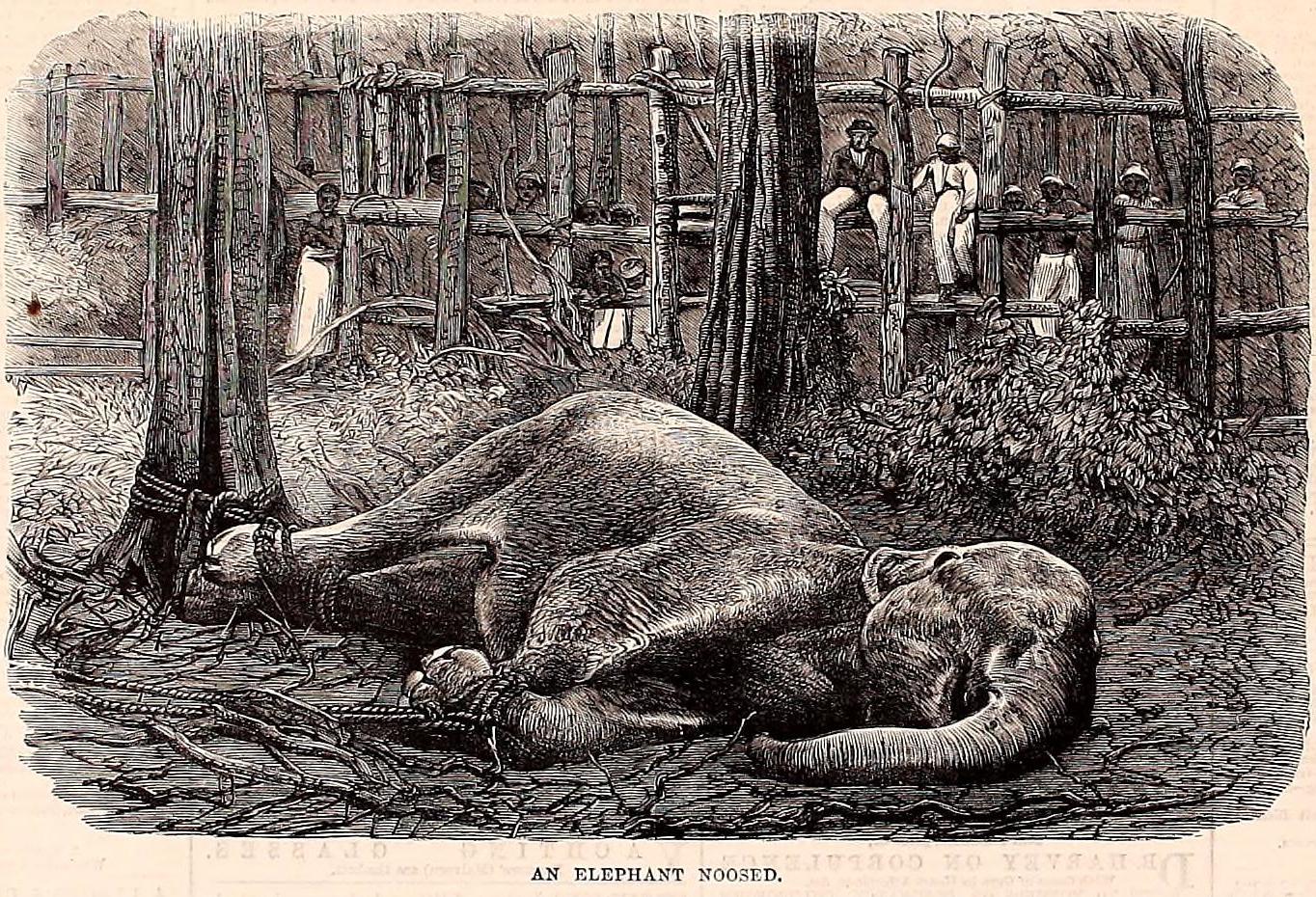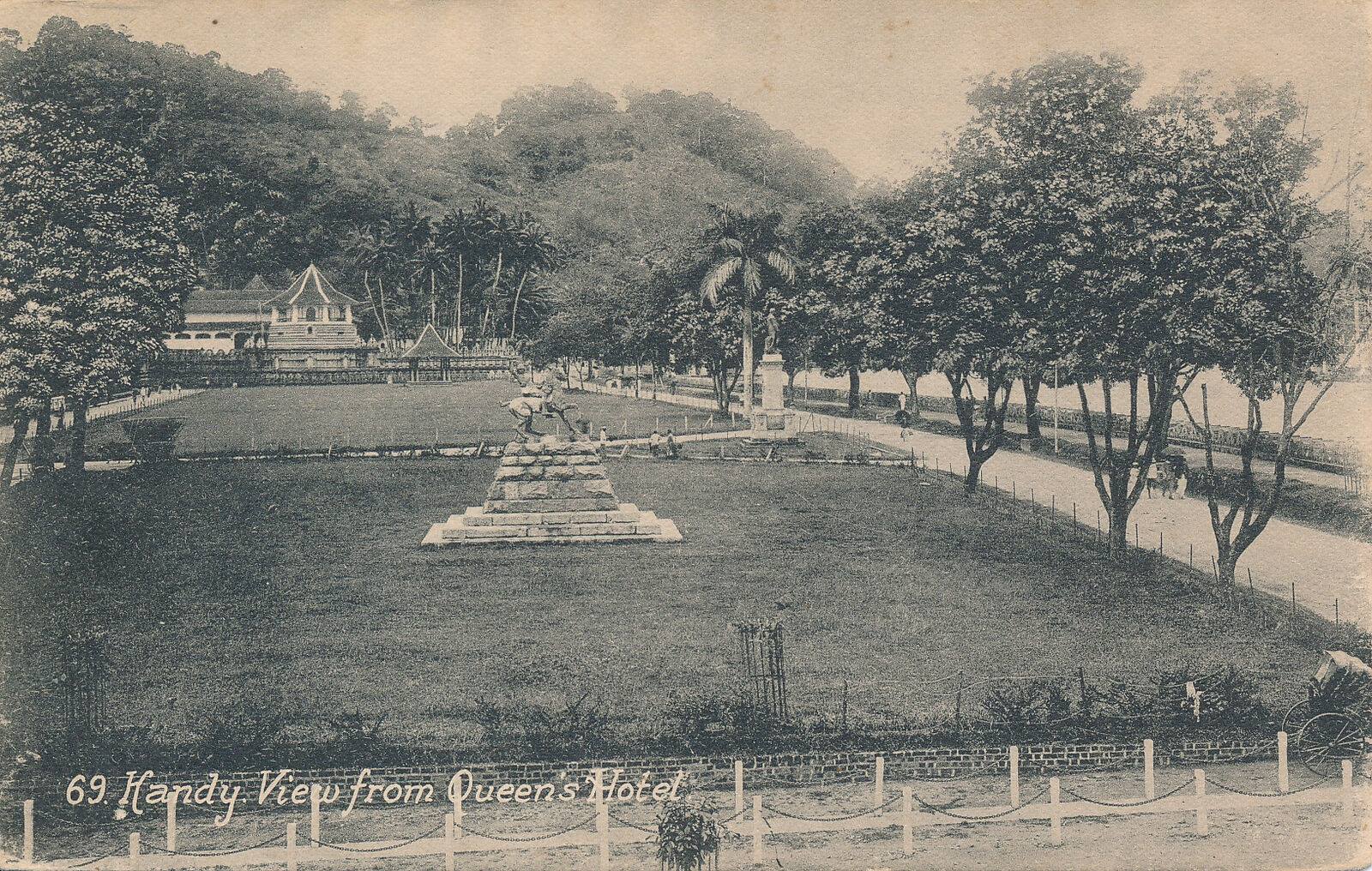Ceylon Elephant Kraal - Ibbawalapitiya
මේ කියන්න යන්නේ 1863 අවුරුද්දේ අගෝස්තු මාසේ ලංකාවේ ඉබ්බාවලපිටිය කියන පළාතේ සිද්ධවෙච්ච අලි අල්ලන කතාවක් ගැන. ඉබ්බාවලපිටිය අලිගාල ඒකාලේ හොඳ ප්රසිද්ධ අලි ගාලක්. මේ අලි අල්ලන පාපතර සෙල්ලම ඒකාලේ බොහොම උත්සවාකාරයෙන් කෙරිච්ච ව්යාපාරික වගේම සංචාරක ආකර්ෂණය දිනාගත්තු කටයුත්තක්.
අලි අල්ලන ක්රාල්
 |
| Ceylon Elephant Kraal, photographed by Skeen & Co. |
ඉතින් මේ කියන අලි අල්ලන දවසෙත් ඒ කාලේ ලංකාවේ නේවාසිකව හිටපු බ්රිතාන්ය ඇතුළු යුරෝපාකරේ බොහෝ දෙනෙකුට පණ පිටින් කැලෑ අලි අල්ලන්නේ කොහොමද කියලා බලන්න එන්න උතුරු පළාතේ රජයේ ඒජන්ත ඕ' ග්රේඩි මහත්තයා හරහා ලොකු ලොකු තනතුරු දරන ස්වදේශික රටේ මහත්තෙයලාගෙන් මුඩ්ලියර්ලාගෙන් ආරාධනා ලැබිලා තිබුණා. මේක එක දවසක වැඩක් එහෙම නෙවි. කැලේ ඇතුළේ කඳවුරු බැඳගෙන දවස් ගාණක් රෑ දවල් ගෙවාගෙන කරන කටයුත්තක්. අලි එකෙක් දෙන්නෙක් අල්ලන්න යන ගමනකුත් නෙවෙයිනේ. අලි අල්ලන්නේ රංචු පිටින්.
 |
| A Struggling Elephant, Ceylon |
තම තමන්ගේ අලිගාල හොඳ මට්ටමක තියාගන්න අලි එකතු කරන මේ වැඩේ සාමාන්යයෙන් කරන නියමිත කාල පරතරයක් තිබුණත් සුද්දන්ගේ මනදොළ පිනවන්න ඒ දේවල් ගණන් ගන්නේ නැති වෙලාවලුත් තියනවා. ඉතින් මෙදාත්, කුරුණෑගල ජයතිලක මුදලිතුමාත්, හල්පෙ රටේ මහත්තයාත්, කුඹුරේවත්තවෙල? (Comburewattawelle) රටේ මහත්තයාත්, ඇතුළු ඒ පළාතේ සිංහල ලොකු ලොක්කෝ ටික ආගන්තුක සුද්දන්ට හොඳ විනෝදයක් සපයන්න මේ දඩ කෙළියට සූදානම් වුණේ එහෙම තමයි. මුදලිතුමාව නම් සංවිධානකටයුතු වලට දක්වපු බලපරාක්රමය ගැන කොළඹ පත්තරවල පසසලාත් තිබුණලු.
 |
| Testing the Rope |
වැඩේ කියන්නේ මෙව්වාට උදව් කරන්න එන ගැමියොත් එන්නේ වැටුපකට එහෙම නෙවි, ස්වේච්ඡාවෙන්. සති තුන හතර විතර ඉඳගෙන අලි අල්ලන ක්රාල් එක හදන්නත්, ක්රාල් එකට අලි කොටු කරගන්න අලි පස්සේ පන්නගෙන එන්නත් එයාලා මහන්සි වෙනවා. සමහර විට රටේ මහත්තයා එන්නයි කිව්වම බැහැයි කියලා කොහොමද! ආවේ නැති වුණොත් ගස් තමයි.!
ක්රාල් - ලන්දේසින්ගෙන් උස්සපු වචනයක්. අලි ගාල කියලත් කියත හැකි. ඉබ්බාවලපිටිය ක්රාල් එක හරි හතරැස් කොටුවක්. අලි ටික කොටුව මැද්දට ආවාම ඇරිච්ච පැති බාධක දාල වහන එකයි කරන්නේ. ක්රාල් එක ඇතුළෙත් තියෙන්නේ කැලෑවම තමයි. කොටුව මැද්දෑවේ පොකුණක් වගේ වතුරක් තියෙන්න ඕනි. දාල තියන පින්තූර වල තියෙන්නා වගේ ගස්වල කඳන් කපලා ඒවා හරස් අතට ගිය දඬු පේළි තුනකින් එකතු කරලා, කැලෙන්ම කපාගත්තු වැල් පොටවල් වලින් බැඳලා, පොළවට හොඳට බස්සලා හදපු අඩි දහයක් දොළහක් උස වැටකින් ක්රාල් එක සමන්විතවෙනවා. හයිය හත්තියට වැට කෙළින් තියෙන්න, මුක්කු ගහල, හරස් අතට ගිය දඬු කෑලිවලට හේත්තු වෙන්න ඇලේට දැව කඳන් තියලා තමයි ගාල් වැට හැදෙන්නේ.
 |
| An Elephant Kraal, With the “Grand Stand” for English Visitors Mode of Capturing Wild Elephants in Ceylon |
ඔය පින්තූරෙ තියන තට්ටු දෙකක නැරඹුම් මඩුව හදලා තියෙන්නේ ක්රාල් එකේ එක් කොනක. ඒ නෝනලා වෙනුවෙන්. ඉබ්බාවලපිටියේ ඒකට කියන්නේ “ග්රෑන්ඩ් ස්ටෑන්ඩ්” කියලා. අලි අල්ලන වැඩේ දැක බලාගන්න ඉබ්බාවලපිටියට එන යුරෝපීය ආගන්තුකයන් 130 දෙනෙකුට විතර වාසයට කඳවුරු විදිහට "ලයින්" නමින් මඩු කිහිපයක් පේළි දෙකකට වෙන්න හදනවා. තල කොළ සහ රිටි වලින් හදන මේ මඩු ඒ කාලේ පුත්තලම්-අනුරාධපුර මහපාර අයින දිගට ගොඩ නැගුණා.
 |
| The Kraal Party at Roadside Rest [Image Credits: http://www.imagesofceylon.com/] |
ඒවායෙන් එක මඩු පෙළක් තනිකඩයන්ටත් අනෙක් මඩු පෙළ විවාහක යුවල සඳහාත් වෙන් කරනවා. "පැලස්" නම් ඉතා විශාලෙට සැප පහසුවට හැදුණු බංගලාව වගේ ගොඩනැගිල්ල වෙන්වෙන්නේ රජයේ ඒජන්ත ඕ' ග්රේඩිටත් ඔහුගේ සුවිශේෂ ආගන්තුකයන්ටත් වාසස්ථාන විදිහට. "රැග් ඇන්ඩ් ෆැමිශ්" විදිහට නම් කරන තවත් විශාල මඩුවක් සැකසෙන්නේ "ලන්ඩන් ආමි ඇන්ඩ් නේවි ක්ලබ්" සාමාජිකයන්ට ඉන්න හිටින්න. මේක නම් බොහොම සද්ද බද්ද ඇති ගොඩනැගිල්ලක්.
 |
| The Kraal Club [Image Credits: http://www.imagesofceylon.com/] |
මේ අතරේ මුවර් ජාතිකයොත් අහල පහළ නගරවල ව්යාපාරිකයොත් ඒ අසල සුරාසැල්, කඩමණ්ඩි, වෙළඳසැල් විවෘත කරලා එහි හිටිවන ගම්මානයක් නිර්මාණය කරනවා. ඇත්තෙන්ම තැපැල් කාර්යාලයක් පවා මේ තාවකාලික ගම්මානය සතුයි. ඉබ්බාවලපිටියට තාවකාලික පදිංචියට එන ආගන්තුකයන්ගේ ලියුම් යැවීම්/එවීම් ඒ නිසා ඇනහිටින්නේ නැහැ.
 |
| Natives at Road Side [Image Credits: http://www.imagesofceylon.com/] |
 |
| Elephants in Kraal Ceylon, photographed by Plate & Co. |
මයිල හතක පමණ වෘත්තාකාර පරිධියක් තුළ විසිරී සිටින අලි 100පමණ රංචුවක් කොටු කරගැනීම ඉතා වෙහෙසකර සහ පරික්ෂාකාරීව සිදු කළ යුතු කාර්යයක්. කෙමෙන් කෙමෙන් මේ වෘත්තාකර ප්රදේශය කුඩා කරගෙන එමින් ක්රාල් එක ඇතුළට අලි පන්නගන්න ඝෝෂා කරන්නන් සහ මුරකරුවන් විශාල ප්රමාණයකගේ දින ගණනක දිවා රාත්රී සහය අවශ්යයි. ඉතින් මේ නිකරුණේ වැය වන කාලය තුළදී විනෝදවෙන්න සුද්දො කරන්නේ අස්ස රේස් පදින එකත්, ගෙනවිත් තියන හීලෑ අලින්ගෙන් අලි රේස් පදින එකත්, දුවන රේස් කරන එකත්. ඒ අතරේ අස්සයන් සහ අලියන් වෙනුවෙන් ඔට්ටු අල්ලන එකත් සිද්ධ වෙනවා. අලි රේස් වලට වැඩි වශයෙන් ඔට්ටු අල්ලන්නේ කාන්තාවන්. නමුත් අලි රේස් එතරම් සාර්ථක වන්නේ නෑ. මොකද හීලෑ අලින් මතට නැගලා යස අගේට පැදවිය හැකි වුණාට තරඟකාරී ලෙස එය කළ හැකි වන්නේ නෑ. එක් තරඟයකදී අලි අතර අන්යෝන්ය සම්මුතියකින්දෝ දිනුම් කණුව ආසන්නයේදිම අලි ටික නැවතුණා.
 |
| The Alarm |
මේ විදිහට නානාප්රකාර දේවල් කරලා සුද්දන් කාලය ගෙවද්දි, සිංහල දඩයක්කාරයෝ ටික කැලෑව අස්සේ අලි රංචුව වට කරගත් කවාකාර පථයේ යාර දහයෙන් දහයට මුර ගිනිදැල් දල්වාගෙන පරීක්ෂාකාරීව ඉන්නවා. කවුරුහරි දැවැන්තයෙක් කවය කඩාගෙන එළියට යන්න තැත් කළොත් සිතුවමේ දැක්වෙන පරිදි ඔවුන් විවිධ ශබ්ද නගමින් ඝෝෂා කරමින් අලින්ට කිසිම හානියක් නොවන ලෙස වෙඩි තබනවා. යටි කැලෑව බොහොම ඝනසැරේට වැඩිලා තියන නිසා මේ වගේ කැලෑවක් අස්සේ යාර විස්සක්වත් ඉදිරිය දකින්නට අමාරුයි. ඒ හන්දා අලි එලවනවා කියන්නේ බොහොම අවධානයෙන් කළයුතු කටයුත්තක්.
 |
| Elephant Kraaling in Ceylon Towards the Stockade (ca. 1890_1910) photographed by Alfred William Amandus Plate |
ඉබ්බාවලපිටිය ක්රාල් එකට ආපු පළමුවන අලියා, දින කිහිපයක්ම වතුර පොදක් කට ගන්නට බැරිවුණ හන්දාදෝ ක්රාල් එක ඇතුළේ තිබිච්ච පොකුණෙන් වතුර බීගෙන බීගෙන ගිහින් ක්රාල් එක මැද්දෙ මැරිලා වැටුණා. එදා රාත්රියේ තවත් අලි විස්සක් විතර ක්රාල් එකට කොටු කරගන්න හැකි වුණා. ඊළඟ උදෑසන ක්රාල් එක ඇතුළේ සිද්දවුණේ කුතුහලය දනවන දෙයක්. පිපාසාවෙන් හාමත්වෙලා හිටිය සත්තු ටික කලබලෙන් පොකුණ මැද්දේ කලබලෙන් එහාට මෙහාට යන්න පටන්ගත්තා. කළු පාට ගඳගහන රොන්මඩ ටික ඒ ඇවිදිල්ලට කැලතිලා ආවා. ඒ මදිවට මැරිච්ච අලියාත් ඒ මැද. කිසි බලාපොරොත්තුවක් නැති දුක්ඛ්ත ස්වභාවයක් තමයි උන්ගේ තිබ්බේ. සමහරවෙලාවට එකෙක් දෙන්නෙක් නැවතිලා මඩ තලියක් අරගෙන ඔළුවේත් ඇඟේත් ගහගත්තා ඕනාවට එපාවට වගේ. තව වෙලාවකට තව එකෙක් මුණින් තලා හිටිය තමන්ගේ සගයගේ ඇඟ හොඬවැලින් අතගාලා බැලුවා. ඒ අතරේ අනෙකුන්ට වඩා එඩිතර අලියෙක් බාධක කඩාගෙන එළියට යන්න දුර්වල උත්සහයක් ගත්තා. ඒත් ගාල් වැටේ නැගගෙන හිටපු මිනිස්සුන්ගේ ඝෝෂා කිහිපයකින් ඌව ආපහු බය කරලා දාන්න පුළුවන් වුණා.
 |
| A Wild Elephant Noosed, Photographed by Plate & Co. |
අලි රංචුව අතරේ පැටැව් කිහිප දෙනෙකුත් හිටියා. අම්මාගේ හොඬවැල සහ ඉදිරි ගාත් අතරේ කැරකි කැරකි සිටි එක් පුංචි පැටියෙක් වැඩුණු ඌරෙකු තරම්වත් ප්රමාණයෙන් ලොකු වී තිබුණේ නැහැ. මඩ ගොඩේ අමාරුවෙන් දඟලා දඟලා ඉඳලා කලබගෑනිය මැද්දේම ඌ හොඳ නින්දකට වැටුණා. නෝනාලා හැමෝගෙම අනුකම්පාව දිනාගත්තේ ඌ. බොහොම ඉඩ කඩ ඇති අට්ටාලයක මේ නෝනලා ටික හිටපු නිසා මේ කටයුත්තේ හොඳ දර්ශනයක් එයාලට දැක බලාගන්න පුළුවන් වුණා. අලි අල්ලන වැඩේ කරන්න තව හීලෑ අලිත් ඕනැ කරනවා. මාර්ග දෙපාර්තමේන්තුවට අයත් හීලෑ ඇතුන් දෙන්නෙක් මේ තැරව්කාර වැඩේට යොදාගෙන තිබ්බා. මේ වෙනකොට ක්රාල් එක ඇතුළේ තිබුණු බොහොමයක් ගහකොළ අලි විසින් බිමට සමතලා කරලා දාලයි තියෙන්නේ. නළල තියලා ගස් පෙරළලා කකුල තියලා අතු පාගලා හොඬවැලෙන් උස්සලා පොළවෙ ගහලා දාන එක උන්ට මහ කජ්ජක් නෙවෙයි. ඒත් මහ ගස් විතරක් ඉතුරුයි. මේ ගස්වල තමයි අලි අල්ලලා බඳින්නේ.
 |
| An Elephant Noosed |
තොණ්ඩු දාලා අල්ලගත්ත පළවෙනි අලියා වයස අවුරුදු දෙකක විතර තරුණ අලියෙක්. ඉස්සල්ලම හීලෑ ඇත්තු දම්මලා මේ අලියව රංචුවෙන් පැත්තකට වෙන් කරවගත්තා. ඌ බිමට පෙරළිච්ච ගස් කඳක් උඩින් යද්දි අලි මේච්චල්කාරයෝ උගේ පිටිපස්සේ කකුලකට තොණ්ඩුව දැම්මා. අහුවුණා කියලා දැනගත්ත අලියා කඹේ කඩන්න දහිරියක් දැම්මත් වැඩේ හරි ගියේ නෑ. ඉතින් බිමට වෙච්ච මේ අලියා මහ හඬින් කෑ ගසන්නට පටන් ගත්තා. ඒ අතරේ හීලෑ ඇතෙකු ඇවිදින් අලි ගෝනියක් ඇදගෙන යන්නා සේ මේ අලි ගැටයාව අට්ටාල ගොඩනැගිල්ල ඉදිරිපිට වූ විවෘත භූමිය වෙත ඇදගෙන යන්න වුණා. හීලෑ ඇත්තු දෙන්නා අලි ගැටයාගේ දෙපැත්තෙන් තියාගෙන ලොකු සටනක් කරලා උගේ කකුල් තුනක් ගහකට තියලා බඳින්න අලි මේච්චල් කාරයන්ට පුළුවන් වුණා. තමන්ගේ නිදහස වෙනුවෙන් සෑහෙන සටනක් මේ අවාසනාවන්ත සතා සිද්ධකලා. හොඬවැලෙන් කඹේ කඩලාදාන්නත් හැකි උපරිමය දරලා විලංගු ඇදලා දාන්නත් උත්සහ කළා. ඇතැම් වෙලාවට බලාපොරොත්තු අතඇරගෙන පොළවේ වැතිරිලා බොහොම දුක්ඛිත ලෙස රැහේ මව් ධේනුවට කෑගසා විලාප දී කතා කළා. ඇයත් පුළුවන් අසලකට වී නිශ්ශබ්දව ඒ දෙස බලා සිටියේ මාතෘත්වයේ දුක, පොළවේ දූවිලි අරගෙන ඔළුවේ ගසාගෙන ප්රකාශ කරලා.
 |
| Elephants In Kraal, Ceylon, photographed by Plate & Co. |
ක්රාල් එකට කොටුවෙච්ච හැම අලියෙකුටම වගේ හිමිවුණේ මේ වගේ දුක්ඛිත ඉරණමක්. හැම අලියෙකුටම මේ හා සමාන බිහිසුණු ප්රචණ්ඩ අත්දැකීමකට මුහුණපාන්න සිද්ධවුණා. පුදුමය නම් තැරැව්කාර ඇතුන්ගෙන් ලැබුණු සහයත් ඔවුන් විවිධ අලියන් වෙත දැක්වූ දෙබිඩි පිළිවෙතත්. තරුණ අලියන් වෙත යම් කාරුණික තැකීමකුත් වැඩිමහල් හෝ යටත් වන්නට අකීකරු වන අලියන් වෙත දරුණු ප්රතිකර්මයකුත් ඔවුන් ලබාදුන්නා. සමහරවිටෙක තරුණ අලියෙකු අල්ලාගන්නා විට චාටුබසින් අවනත කරගන්නට උන් තම හොඬවැලෙන් අලියාව අතගානවා. ඒ වගේම හොඳම පොල් වලින් ඌට සංග්රහ කරනවා. ඒත් තමන්ගේ ඔක්කෝම උප්පරවැට්ටි දාලත් කීකරු වෙන්නේ නැති වැඩිමහල් එකෙකුගේ නම් ලේ සොලවන්න උන් පසුබට වෙන්නේ නැහැ.
 |
| Taming a Wild Elephant |
මේ විදිහට අලියව අල්ලලා විලංගු දාල පැය කිහිපයක් තිබ්බම උගේ ආත්මය යම් විදිහකට බිඳෙනවා. ඊට පස්සේ කරන්නේ හීලෑ අලි දෙන්නෙක් දෙපැත්තේ තියාගෙන ඌව ගඟට අරන් යන එක. උගේ කරටත් ඌව ගෙනියන කොන්දොස්තර අලි දෙන්නාගේ කරටත් කඹයක් බැඳෙනවා. ඇට්ටර අලියෙක් වුණොත් හීලෑ අලි පස් දෙනෙක්වත් ඕනෑ කරනවා ගඟට දක්කගෙන යන්න. ගඟට ගියාම හාමත් වුණු ගිනියම් වුණු ශරීරය සිසිල් ජලයෙන් නහවාගෙන සා පිපාසාව සංසිඳව ගන්නට මේ අසරණ සතුන්ට අන්තිමේදි හැකියාව ලැබෙනවා. ගඟෙන් ගොඩට ආවම ඌව ආපසු ක්රාල් එක අසල පිහිටි වෙනත් ගසක ගස් බඳිනවා. අලියන්ට නම් තැබීමත් මේ උත්සවයේ අංගයක්. හැබැයි එහෙම කරන්නේ උගේ පිටේ අලි ගොව්වෙක් ඉස් ඉස්සලාම නැගලා යන සුභ මොහොතට. ජයතිලක මුදලිට හිමිවුණු තරුණ අලි ගැටයෙක් මේ විදිහට මෙච්චල් කරගෙන විනාඩි කිහිපයකින් උගේ පිටේ නැග යන විට ඔහු ඌට "හුරතලා" යන නම ලබාදුන්නා. මේ කියන දවසේ අල්ලාගත් අලියන්ගේ ගණන 45ක්. තිදෙනෙක් මියැදුනා. අනෙකුත් උන්ට පැන යන්නට ඉඩ ලැබුණා.
 |
| Herd of Wild Elephants |
අපි මේ කතාව සහ සිතුවම් උපුටා ගන්නේ ඉලස්ට්රේටඩ් ලන්ඩන් පුවත් පතින්. එයාලා ඒ කතාව උපුටාගෙන තියෙන්නේ සිලෝන් එක්සැමිනර් පුවත් පතින්. ඔය දාලා තියන සිතුවම් ටික ඇඳලා තියෙන්නේ මහනුවර වාසය කරන ජේ. ඩී හර්බර්ට් ගත්තු ඡායාරූප පාදක කරගෙන.
Ref: The Illustrated London News – August 13, 1864 pg 167-168
 |
| Wild elephants Inside the Stockade Great Kraal of 1902 Photographed by Underwood & Underwood. |






Comments
Post a Comment